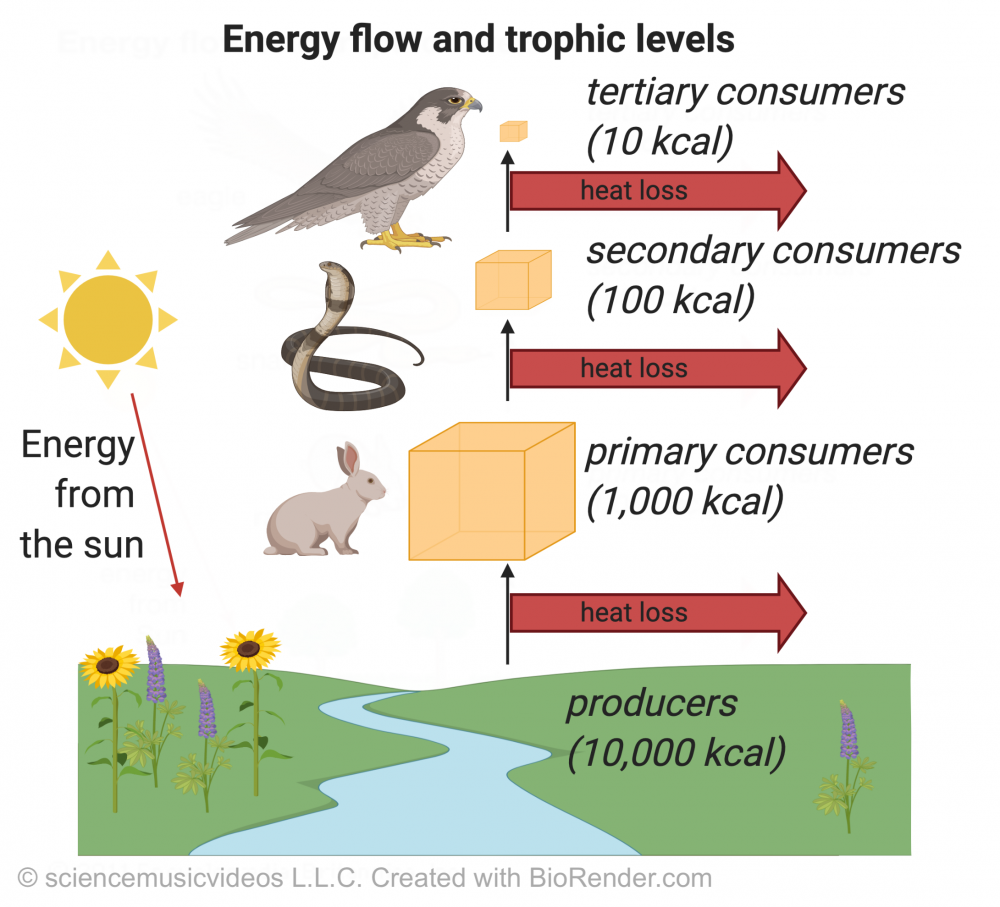1. Introduction
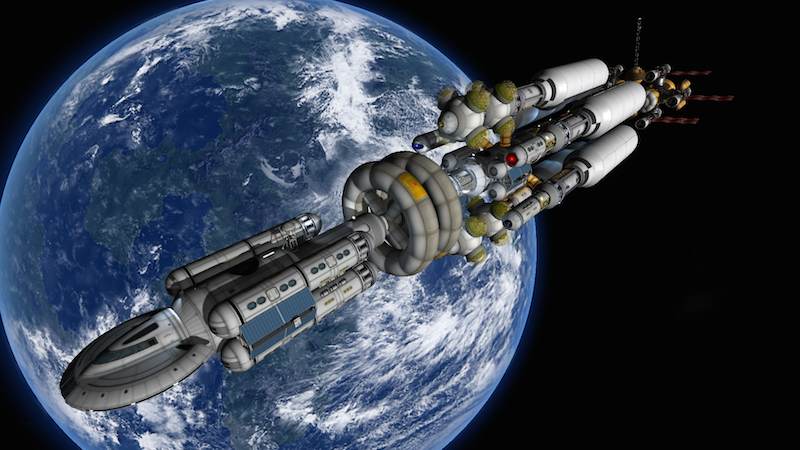
At the end of the last module, you responded to this thought-experiment:
- You’re the director of a mission to colonize a planet in another solar system.
- Your spaceship will carry colonists on a decades-long journey to your new home.
- You have to grow your food on the ship.
Decision: to maximize crew size, are you going to direct your crew to eat as vegetarians or carnivores?
There is an answer, and it lies in the principles of ecology. Let’s take a look.
2. The Easy Math of Energy Transfer in Trophic Levels
To keep the math easy, let’s set 2000 Calories/day as our average target calorie intake for each crewperson.
Remember that our ship can produce a lot of energy: enough to grow 2,000,000 food calories worth of food each day. What we’re growing, of course, are plants. If we stick to a strict vegetarian diet, then the math is straightforward: 2,000,000 calories of plant food/day, divided by 2000 calories/day/crewperson= 1000 crew people.
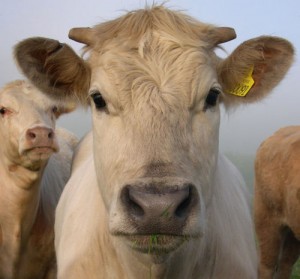
But what happens if we wanted to eat as carnivores? We would take the seeds, grain, leaves, and other plant food that we produced on our ship’s farms, and we would feed it to cows (or other animals, such as chickens). Then, instead of eating plant foods like bread and apples, we’d eat steak. If we measured the amount of chemical energy available to us from the cows, how much energy would be available for the crew?
Make a prediction:
[qwiz style = “border: 3px solid black; ” qrecord_id=”sciencemusicvideosMeister1961-What happens to two million calories (HS)”]
[h]What happens to 2,000,000 plant calories ….
[q] If 2,000,000 calories are available from plants, how many calories will be available if we feed those plants to animals, and then eat the animals?
[c]MjAsMDAwLDAwMA==[Qq]
[c]MiwwMDAsMDAw[Qq]
[c]MjAwLD AwMA==[Qq]
[f]Tm8uIFdoYXQgeW91JiM4MjE3O3JlIHN1Z2dlc3RpbmcgaXMgdGhhdCAyLDAwMCwwMDAgY2Fsb3JpZXMgaW4gcGxhbnRzIHdpbGwgYmVjb21lIDIwLDAwMCwwMDAgY2Fsb3JpZXMgaW4gYW5pbWFscy4gTm90IHBvc3NpYmxlLiBBIGtleSBwcmluY2lwbGUgaW4gcGh5c2ljcyBpcyB0aGF0IGFueSB0aW1lIHlvdSB0cmFuc2Zvcm0gZW5lcmd5IGZyb20gb25lIGZvcm0gdG8gYW5vdGhlciwgeW91IGxvc2UgZW5lcmd5LiBBIG1lYXQgYmFzZWQgZGlldCB3aWxsIHRha2UgdGhlIDIsMDAwLDAwMCBjYWxvcmllcyB5b3UgaGFkIGluIHBsYW50IGZvb2QsIGFuZCByZWR1Y2UgaXQgdG8gMjAwLDAwMCBjYWxvcmllcyBpbiBtZWF0Lg==[Qq]
[f]Tm8uIFdoYXQgeW91JiM4MjE3O3JlIHN1Z2dlc3RpbmcgaXMgdGhhdCAyLDAwMCwwMDAgY2Fsb3JpZXMgaW4gcGxhbnRzIHdpbGwgc3RheSB0aGUgc2FtZSBhZnRlciBiZWluZyBmZWQgdG/CoGFuaW1hbHMuIE5vdCBwb3NzaWJsZS7CoEEga2V5IHByaW5jaXBsZSBpbiBwaHlzaWNzIGlzIHRoYXQgYW55IHRpbWUgeW91IHRyYW5zZm9ybSBlbmVyZ3kgZnJvbSBvbmUgZm9ybSB0byBhbm90aGVyLCB5b3UgbG9zZSBlbmVyZ3kuIEEgbWVhdCBiYXNlZCBkaWV0IHdpbGwgdGFrZSB0aGUgMiwwMDAsMDAwIGNhbG9yaWVzIHlvdSBoYWQgaW4gcGxhbnQgZm9vZCwgYW5kIHJlZHVjZSBpdCB0byAyMDAsMDAwIGNhbG9yaWVzIGluIG1lYXQu[Qq]
[f]WWVzLiAyLDAwMCwwMDAgY2Fsb3JpZXMgaW4gcGxhbnRzIHlpZWxkIGFib3V0IDIwMCwwMDAgY2Fsb3JpZXPCoGFmdGVyIGJlaW5nIGZlZCB0b8KgYW5pbWFscy4gQSBrZXkgcHJpbmNpcGxlIGluIHBoeXNpY3MgaXMgdGhhdCBhbnkgdGltZSB5b3UgdHJhbnNmb3JtIGVuZXJneSBmcm9tIG9uZSBmb3JtIHRvIGFub3RoZXIsIHlvdSBsb3NlIGVuZXJneSwgYW5kIHlvdSYjODIxNztyZSBzZWVpbmcgdGhpcyBwcmluY2lwbGUgaW4gYWN0aW9uLg==[Qq]
[x]
[restart]
[/qwiz]
Scroll down a bit to continue.
As, you’ve just seen, here are the numbers:
| 1) Harvestable food energy available in plants | 2,000,000 calories |
| 2) Harvestable food energy available in animals that eat the plants | 200,000 calories |
Harvestable energy means exactly what it says. Imagine taking all of the plants that we can grow on the ship, harvesting them, and measuring their energy. That would be the first row: harvestable energy available in plants. The second row is the energy available to us from the meat of the animals that ate the plants.
Note that the total food energy that we could harvest from the cows is only 10% of the energy in the plants that we fed to the cows. Or, using the terms related to trophic levels that we learned in the previous tutorial, the harvestable energy in the producers (plants) is ten times as great as the harvestable energy in primary consumers.
The loss of 90% of the available food energy from producers to consumers is a well-known rule in ecology. The rule is called the 10 Percent Rule. To make sure that you’re getting this, try to label the diagram below. Note that in this ecosystem, the energy available in the producers starts at 600,000 units of energy.
[qwiz style=”width: 700px !important; min-height: 400px !important;” qrecord_id=”sciencemusicvideosMeister1961-Trophic Levels and Harvestable Energy (HS)”]
[h]Interactive Diagrams: Trophic Levels and Harvestable Energy
[q labels = “top”]
[l]producers
[fx] No. Please try again.
[f*] Correct!
[l]primary consumer
[fx] No. Please try again.
[f*] Excellent!
[l]secondary consumer
[fx] No, that’s not correct. Please try again.
[f*] Correct!
[l]Third-level consumer
[fx] No, that’s not correct. Please try again.
[f*] Good!
[l]600,000
[fx] No. Please try again.
[f*] Good!
[l]60,000
[fx] No, that’s not correct. Please try again.
[f*] Excellent!
[l]6,000
[fx] No. Please try again.
[f*] Excellent!
[l]600
[fx] No, that’s not correct. Please try again.
[f*] Great!
[q multiple_choice=”true”]If an ecosystem has 500,000 units of harvestable energy available in its producers, the amount of energy available from the primary consumers will be
[c]NTAwLDAwMCB1bml0cw==[Qq]
[f]Tm8uIFJlbWVtYmVyIHRoZSAxMCUgcnVsZS4gV2hhdCYjODIxNztzIDEwJSAob25lIHRlbnRoKSBvZiA1MDAsMDAwPw==[Qq]
[c]NTAsMDAw IHVuaXRz[Qq]
[f]Q29ycmVjdC4gNTAsMDAwIGlzIDEwJSBvZiA1MDAsMDAwLg==[Qq]
[c]NTAwMCB1bml0cw==[Qq]
[f]Tm8uIFJlbWVtYmVyIHRoZSAxMCUgcnVsZS4gV2hhdCYjODIxNztzIDEwJSAob25lIHRlbnRoKSBvZiA1MDAsMDAwPw==[Qq]
[q multiple_choice=”true”]How much energy gets lost as energy gets transferred from one trophic level to the next?
[c]OTkl[Qq]
[f]Tm8uIFJlbWVtYmVyIHRoZSAxMCUgcnVsZS4gV2hhdCYjODIxNztzIDEwMCAmIzgyMTE7IDEwPw==[Qq]
[c]OSU=[Qq]
[f]Tm8uIFJlbWVtYmVyIHRoZSAxMCUgcnVsZS4gV2hhdCYjODIxNztzIDEwMCAmIzgyMTE7IDEwPw==[Qq]
[c]OT Al[Qq]
[f]RXhhY3RseS4gSWYgMTAlIGdldHMgdHJhbnNmZXJyZWQsIHRoYXQgbWVhbnMgdGhhdCA5MCUgZ2V0cyBsb3N0Lg==[Qq]
[x]
[restart]
[/qwiz]
What the 10% rule says is this: If you gathered up all of the primary producers and measured their chemical energy, and then did the same with the herbivores/primary consumers, the herbivores would have only 10% of the total chemical energy that was available in the producers. And, if you gathered up all of the secondary consumers/carnivores, and compared the energy in that trophic level to the energy in the primary consumers, you’d find that once again, you’d only transferred 10% of the energy.
Let’s apply the 10% rule to the issue of largest possible crew size on our spaceship to Alpha Centauri.
[qwiz style=”width: 700px !important; min-height: 400px !important;” qrecord_id=”sciencemusicvideosMeister1961-10 Percent Rule Though Experiment (HS)”]
[h]The 10% rule and crew size on our trip to Alpha Centauri
[q labels = “top”]
[l]producer
[fx] No. Please try again.
[f*] Good!
[l]primary consumer
[fx] No. Please try again.
[f*] Excellent!
[l]secondary consumer
[fx] No. Please try again.
[f*] Great!
[l]2,000,000
[fx] No. Please try again.
[f*] Great!
[l]200,000
[fx] No. Please try again.
[f*] Great!
[l]CARNIVORE CREW
[fx] No, that’s not correct. Please try again.
[f*] Correct!
[l]HERBIVORE CREW
[fx] No, that’s not correct. Please try again.
[f*] Good!
[/qwiz]
To translate what’s above into actual crew-sizenumbers, here’s the math.
- Eating as primary consumers/vegetarians, you’d have 2,000,000 calories available for the crew. At an average of 2,000 calories/crewmember, that would get you a crew of 1,000.
- Eating as secondary consumers/carnivores, you’ve have 200,000 calories available for the crew. At an average of 2,000 calories/crewmember, your crew size drops to 100.
In terms of founding a colony, more colonists is better. It maximizes genetic diversity, keeping your population more adaptable. The vegetarian strategy is the wiser course of action.
Of course, the actual decision would be much more nuanced. In terms of food consumption, you’d have to consider the fact that humans are omnivores. It’s probably wise for the crew to have access to some animal protein. And the energy equation becomes very different if you’re considering animal products (eggs from chicken, dairy from cows) as opposed to meat. But given the limits of size of ship and amount of energy it can produce, it makes sense to have the crew eat primarily as herbivores, instead of primarily as carnivores.
3. The Math of Trophic Levels: Flashcards
[qdeck qrecord_id=”sciencemusicvideosMeister1961-Trophic Level Math (HS)”]
[h]The math of trophic levels: Flashcards
[i]
[q]Back to our interstellar voyage. Since your ship will have a fixed amount of energy, what’s the best feeding strategy for maximizing crew size? Justify your answer.
[a]If you have a fixed amount of energy, the best feeding strategy for maximizing crew size is to have the crew eat like herbivores. That’s because only 10% of the energy gets passed between one trophic level and the next. If the crew eats as herbivores,there will be ten times as much food energy, and you’ll be able to support a much larger crew.
[q]In terms of the relationship between producers and primary consumers, the 10% rule says that ….
[a]In terms of the relationship between producers and primary consumers, the 10% rule says that only 10% of the chemical energy in the producers will get passed to the producers.
[q]How much available energy gets lost in the transfer of energy from one trophic level to the next?
[a]In the transfer of energy from one trophic level to the next, 90% of the available energy gets lost.
[/qdeck]
4. Understanding the 10% Rule
 Why is so little energy transferred from one trophic level to the next?
Why is so little energy transferred from one trophic level to the next?
4a. Some energy is lost as heat
One reason has to do with the laws of physics. Whenever energy is transformed from one form to another, some of the energy gets lost as heat.
If that feels abstract, just think about what happens in a car. A car transforms the energy in gasoline into the energy of motion. But during that energy transfer, a lot of the energy in the gasoline is lost as heat. You can feel that heat coming off a car’s hood. That heat is wasted energy that isn’t moving your car. Instead, that lost heat energy dissipates (disperses, diffuses) into the environment.
In living things, the fuel is glucose. To sustain life, the cells that make up living things transform the chemical energy in glucose into ATP. That process is called cellular respiration (a process that you should be familiar with at this point in your studies of biology).
glucose + oxygen → carbon dioxide + water + energy (ATP)
As energy in glucose is transformed into the energy of ATP, about 60% of the energy is lost as heat.
There’s more energy lost as cells convert ATP into ADP and phosphate.
![]()
Similarly, many of the food calories that you would feed to a cow, as they are used by the cow to keep itself alive, dissipate as heat into the environment. Add to that the fact that a cow is a mammal with a body temperature similar to yours, and you get an even greater loss of energy to heat. All of the chemical energy lost as heat is not going to be available to the next trophic level.
In my Food Chain Song (the music video is embedded below), I refer to the heat loss as “metabolic rent.” Metabolism is the term used for all of the chemical reactions that happen inside living things. A cell is a complex chemical system, and all of those chemical reactions occurring within cells make up a large portion of the energy that’s lost in the transfer between trophic levels.
4b. Some food energy isn’t absorbed
But there are additional reasons why energy transfer between trophic levels is so inefficient. The diagram below, which shows a caterpillar harvesting energy from a leaf, shows heat loss, and one additional source of energy loss. Note that this diagram uses Joules (J) instead of Calories. The proportions would be the same.
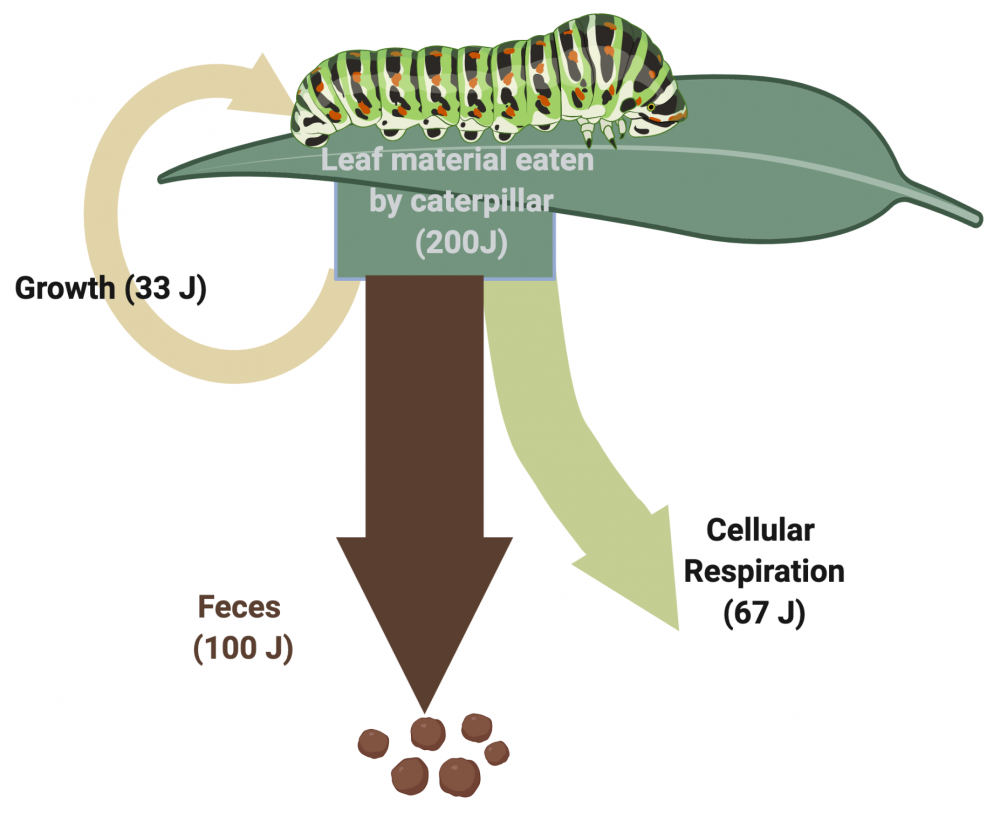
The 67 J arrow on the right side (cellular respiration) is the heat loss that we’ve described above: it’s the energy that the caterpillar is using just to keep itself alive. But note the brown 100J arrow to the left labeled “feces.” Not everything that an organism ingests goes making more of that organism. Some ingested food is indigestible, and passes right through. On an ecological level, all of that defecated matter doesn’t become available to the next trophic level.
So, in the diagram above, what’s left to be transferred to the next trophic level? Only the 33J labeled as “growth.”
The fact that 33/200 is 16.5%, as opposed to to 10%, might seem confusing. But remember that this an analysis of one animal eating a part of a plant. If you widen the analysis to thinking about the actual organisms living in an ecosystem, you can find additional reasons for energy loss between trophic levels. We’ll do that in a moment, but first, answer the questions below.
[qwiz qrecord_id=”sciencemusicvideosMeister1961-Ten Percent Rule in Action (HS)”]
[h]Quiz: The 10% rule in action
[q] In the diagram below, what is the amount of energy that passes through the caterpillar, but which can’t be absorbed into the caterpillar.
[c]MTAw Sg==[Qq]
[c]MzNK[Qq]
[c]NjdK[Qq]
[c]MjAwSg==[Qq]
[f]WWVzLiAxMDAgSiBpcyBsYWJlbGVkIGFzICYjODIyMDtmZWNlcy4mIzgyMjE7IFRoYXQmIzgyMTc7cyBmb29kIGVuZXJneSB0aGF0IHBhc3NlcyB0aHJvdWdoIHVzLCBidXQgd2hpY2ggd2UgY2FuJiM4MjE3O3QgYWJzb3JiLg==[Qq]
[f]Tm8uIDMzSiBpcyBsYWJlbGVkIGFzICYjODIyMDtncm93dGguJiM4MjIxOyBUaGF0IG1lYW5zIHRoYXQgdGhpcyBlbmVyZ3kgZ2V0cyBpbmNvcnBvcmF0ZWQgaW50byBidWlsZGluZyBtb3JlIGNhdGVycGlsbGFyLg==[Qq]
[f]Tm8uIDY3SiBpcyBsYWJlbGVkIGFzICYjODIyMDtjZWxsdWxhciByZXNwaXJhdGlvbi4mIzgyMjE7IFRoYXQgbWVhbnMgdGhhdCB0aGlzIGVuZXJneSBpcyB1c2VkIHRvIGtlZXAgdGhlIGNhdGVycGlsbGFyIGFsaXZlLCBvciBpcyBsb3N0IGFzIGhlYXQgdG8gdGhlIGVudmlyb25tZW50Lg==[Qq]
[f]Tm8uIDIwMEogaXMgdGhlIG9yaWdpbmFsIGFtb3VudCBvZiBmb29kIGVuZXJneSBpbiB0aGUgbGVhZiB0aGF0IHdhcyBjb25zdW1lZCBieSB0aGUgY2F0ZXJwaWxsYXIu[Qq]
[q] In the diagram below, what is the amount of food energy that the caterpillar consumes.
[c]MTAwSg==[Qq]
[c]MzNK[Qq]
[c]NjdK[Qq]
[c]MjAw Sg==[Qq]
[f]Tm8uIDEwMCBKIGlzIGxhYmVsZWQgYXMgJiM4MjIwO2ZlY2VzLiYjODIyMTsgVGhhdCYjODIxNztzIGZvb2QgZW5lcmd5IHRoYXQgcGFzc2VzIHRocm91Z2ggdXMsIGJ1dCB3aGljaCB3ZSBjYW4mIzgyMTc7dCBhYnNvcmIu[Qq]
[f]Tm8uIDMzSiBpcyBsYWJlbGVkIGFzICYjODIyMDtncm93dGguJiM4MjIxOyBUaGF0IG1lYW5zIHRoYXQgdGhpcyBlbmVyZ3kgZ2V0cyBpbmNvcnBvcmF0ZWQgaW50byBidWlsZGluZyBtb3JlIGNhdGVycGlsbGFyLg==[Qq]
[f]Tm8uIDY3SiBpcyBsYWJlbGVkIGFzICYjODIyMDtjZWxsdWxhciByZXNwaXJhdGlvbi4mIzgyMjE7IFRoYXQgbWVhbnMgdGhhdCB0aGlzIGVuZXJneSBpcyB1c2VkIHRvIGtlZXAgdGhlIGNhdGVycGlsbGFyIGFsaXZlLCBvciBpcyBsb3N0IGFzIGhlYXQgdG8gdGhlIGVudmlyb25tZW50Lg==[Qq]
[f]WWVzLiAyMDBKIGlzIHRoZSBvcmlnaW5hbCBhbW91bnQgb2YgZm9vZCBlbmVyZ3kgaW4gdGhlIGxlYWYgdGhhdCB3YXMgY29uc3VtZWQgYnkgdGhlIGNhdGVycGlsbGFyLg==[Qq]
[q] In the diagram below, what is the amount of energy that passes through the caterpillar consumes, and which becomes more caterpillar.
[c]MTAwSg==[Qq]
[c]Mz NK[Qq]
[c]NjdK[Qq]
[c]MjAwSg==[Qq]
[f]Tm8uIDEwMCBKIGlzIGxhYmVsZWQgYXMgJiM4MjIwO2ZlY2VzLiYjODIyMTsgVGhhdCYjODIxNztzIGZvb2QgZW5lcmd5IHRoYXQgcGFzc2VzIHRocm91Z2ggdXMsIGJ1dCB3aGljaCB3ZSBjYW4mIzgyMTc7dCBhYnNvcmIu[Qq]
[f]WWVzLiAzM0ogaXMgbGFiZWxlZCBhcyAmIzgyMjA7Z3Jvd3RoLiYjODIyMTsgVGhhdCBtZWFucyB0aGF0IHRoaXMgZW5lcmd5IGdldHMgaW5jb3Jwb3JhdGVkIGludG8gYnVpbGRpbmcgbW9yZSBjYXRlcnBpbGxhci4=[Qq]
[f]Tm8uIDY3SiBpcyBsYWJlbGVkIGFzICYjODIyMDtjZWxsdWxhciByZXNwaXJhdGlvbi4mIzgyMjE7IFRoYXQgbWVhbnMgdGhhdCB0aGlzIGVuZXJneSBpcyB1c2VkIHRvIGtlZXAgdGhlIGNhdGVycGlsbGFyIGFsaXZlLCBvciBpcyBsb3N0IGFzIGhlYXQgdG8gdGhlIGVudmlyb25tZW50Lg==[Qq]
[f]Tm8uIDIwMEogaXMgdGhlIG9yaWdpbmFsIGFtb3VudCBvZiBmb29kIGVuZXJneSBpbiB0aGUgbGVhZiB0aGF0IHdhcyBjb25zdW1lZCBieSB0aGUgY2F0ZXJwaWxsYXIu[Qq]
[q] In the diagram below, what is the amount of energy that the caterpillar consumes, but which gets spent supporting the caterpillar’s own life processes, or is lost as heat?
[c]MTAwSg==[Qq]
[c]MzNK[Qq]
[c]Nj dK[Qq]
[c]MjAwSg==[Qq]
[f]Tm8uIDEwMCBKIGlzIGxhYmVsZWQgYXMgJiM4MjIwO2ZlY2VzLiYjODIyMTsgVGhhdCYjODIxNztzIGZvb2QgZW5lcmd5IHRoYXQgcGFzc2VzIHRocm91Z2ggdXMsIGJ1dCB3aGljaCB3ZSBjYW4mIzgyMTc7dCBhYnNvcmIu[Qq]
[f]Tm8uIDMzSiBpcyBsYWJlbGVkIGFzICYjODIyMDtncm93dGguJiM4MjIxOyBUaGF0IG1lYW5zIHRoYXQgdGhpcyBlbmVyZ3kgZ2V0cyBpbmNvcnBvcmF0ZWQgaW50byBidWlsZGluZyBtb3JlIGNhdGVycGlsbGFyLg==[Qq]
[f]WWVzLiA2N0ogaXMgbGFiZWxlZCBhcyAmIzgyMjA7Y2VsbHVsYXIgcmVzcGlyYXRpb24uJiM4MjIxOyBUaGF0IG1lYW5zIHRoYXQgdGhpcyBlbmVyZ3kgaXMgdXNlZCB0byBrZWVwIHRoZSBjYXRlcnBpbGxhciBhbGl2ZSwgb3IgaXMgbG9zdCBhcyBoZWF0IHRvIHRoZSBlbnZpcm9ubWVudC4=[Qq]
[f]Tm8uIDIwMEogaXMgdGhlIG9yaWdpbmFsIGFtb3VudCBvZiBmb29kIGVuZXJneSBpbiB0aGUgbGVhZiB0aGF0IHdhcyBjb25zdW1lZCBieSB0aGUgY2F0ZXJwaWxsYXIu[Qq]
[x]
[restart]
[/qwiz]
4.c. The organisms in higher trophic levels only harvest some of the energy below
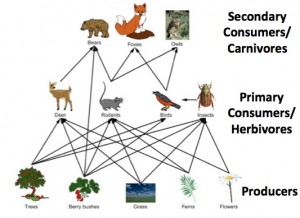
We’ve seen above that some of the energy that’s transferred between trophic levels is lost as heat. Additional energy is lost because not everything that an animal ingests gets absorbed into its body.
Here’s a third reason. The primary consumers are not going to be able to eat every last piece of the plants below them. Just think of yourself as a primary consumer. If you eat rice, for example, you’re eating only a tiny portion of that plant. Or consider eating an apple: there’s the whole rest of the tree that you’re not consuming. Similarly, when you eat as a carnivore, you eat only a tiny portion of the animal that was killed to feed you. When you eat chicken, you mostly eat the muscle tissue around the breasts, back, and legs. All the rest of the chicken (bones, innards, head, feet, etc). doesn’t get transferred to you.
Here’s how I summarize this in my Food Chain Song.
Each level in a food chain yields only ten percent
Of the former level’s energy you might ask where it went
There are bones and leaves you can’t digest that really make a dent
And don’t ignore the weighty cost of metabolic rent.
4d. Ecological Pyramids show the 10% rule
Ecologists have organized the energy loss in ecosystems into a pyramid of energy. In the pyramid, you can see available energy dropping by 90% from one trophic level to the next. Remember: 90% of the energy is lost. Only 10% is transferred.
There are other ecological pyramids that show other aspects of ecosystem structure. But before we look at those, let’s consolidate understanding with some flashcards.
5. Flashcards: Energy Transfer Between Trophic Levels
[qdeck qrecord_id=”sciencemusicvideosMeister1961-Energy Transfer Between Trophic Levels (HS)”]
[h]Flashcards: Energy Transfer Between Trophic Levels
[q]An image like the one below is called a
[a]An image like the one below is called a pyramid of energy.
[q]In an ecosystem, approximately _______ % of the energy is transferred from one ____________ ___________ to the one above it.
[a]In an ecosystem, approximately 10 % of the energy is transferred from one trophic level to the one above it.
[q]Explain the diagram below.
[a]The diagram below is saying that a significant amount of the food energy ingested by a consumer isn’t used for growth. A a significant fraction is used during cellular respiration by the consumer to sustain its own life processes. Another significant fraction simply passes through the body of a consumer, and is eliminated as feces.
[q]Explain the 10% rule. You should be able to list three reasons
[a]The 10% rule is based on
- The laws of physics. In any transfer of energy, some of the available energy is lost as heat.
- Not all of the food that an organism ingests can be absorbed. Some passes right through as feces.
- Not all of the energy available at one trophic level is harvested by the organisms in the level above it. Primary consumers don’t eat every last bit of the producers. Carnivores don’t eat every last herbivore.
[/qdeck]
6. Other Ecological Pyramids
In addition to the pyramid of energy, there are two additional ecological pyramids to know about.
One is a pyramid of numbers. This pyramid shows the actual number of organisms at each trophic level. In the pyramid of numbers below, you see that 1,500,000 producers support 200,000 herbivores. These herbivores support 90,000 secondary consumers, who in turn support one top-level carnivore.
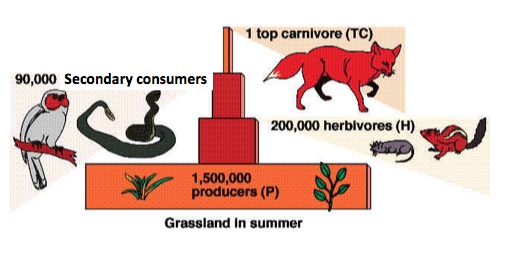
But unlike a pyramid of energy, which is always widest at its base, the pyramid of numbers can have a base that’s narrower than the levels above. Consider a forest ecosystem where one tree might support thousands of insects, which are preyed upon by birds. That pyramid would look like this:
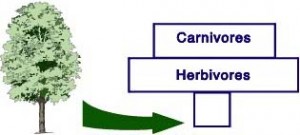
Ecosystems can also be represented through a pyramid of biomass. Biomass is living matter, and a biomass pyramid shows the amount of living matter in each trophic level. Here’s a typical biomass pyramid.
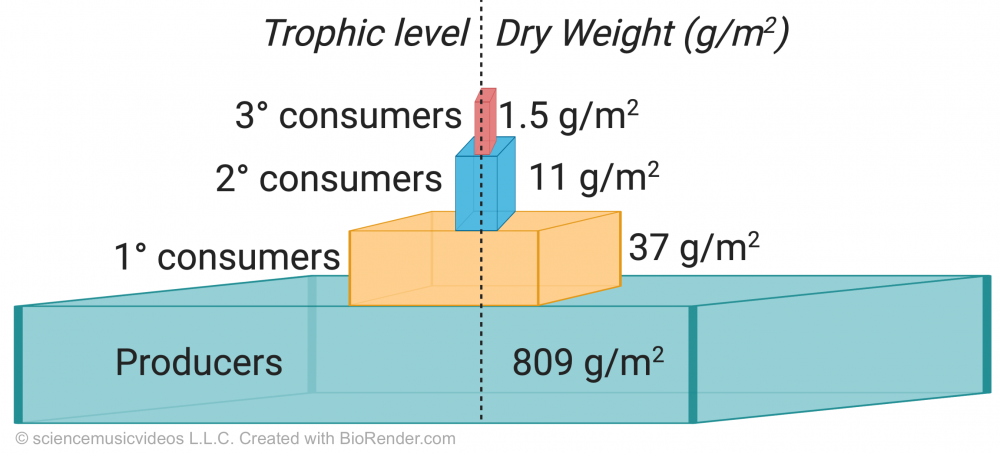
Like a pyramid of numbers, there are biomass pyramids that are inverted, with the base more narrow than the layers above. But that goes beyond the scope of our efforts here. If you want to read more about pyramids of biomass, you can follow this link to Wikipedia.
7. Ecological Pyramids: Checking Understanding
Let’s check your understanding of ecological pyramids with this quiz.
[qwiz qrecord_id=”sciencemusicvideosMeister1961-Ecological Pyramids, Checking Understanding (HS)”]
[h]Quiz: Ecological Pyramids: Checking Understanding
[q] The diagram below shows a
[c]cHlyYW1pZCBvZiBlbmVyZ3k=[Qq]
[c]cHlyYW1pZCBvZiBiaW9tYXNz[Qq]
[c]cHlyYW1pZCBv ZiBudW1iZXJz[Qq]
[f]Tm8uIEEgcHlyYW1pZCBvZiBlbmVyZ3kgZGlmZmVyZW5jZXMgYXQgZWFjaCB0cm9waGljIGxldmVsLiBZb3UgY291bGQgaWRlbnRpZnkgdGhpcyBieSBlbmVyZ3ktcmVsYXRlZCB1bml0cyBzdWNoIGFzICYjODIyMDtqb3VsZXMsJiM4MjIxOyAmIzgyMjA7Y2Fsb3JpZXMsJiM4MjIxOyBldGMu[Qq]
[f]Tm8uIEJpb21hc3MgaXMgbGl2aW5nIG1hdHRlci4gQSBweXJhbWlkIG9mIGJpb21hc3Mgc2hvd3MgZGlmZmVyZW5jZXMgaW4gYmlvbWFzcyBhdCBlYWNoIHRyb3BoaWMgbGV2ZWwuIFlvdSBjb3VsZCBpZGVudGlmeSBpdCBieSB1bml0cyBzdWNoIGFzIGdyYW1zIG9yIGtpbG9ncmFtcy4=[Qq]
[f]WWVzLiBUaGlzIGlzIGEgcHlyYW1pZCBvZiBudW1iZXJzLCBhbmQgc2hvd3MgdGhlIG51bWJlciBvZiBvcmdhbmlzbXMgYXQgZWFjaCB0cm9waGljIGxldmVsLg==
Cg==[Qq]
[q] The diagram below shows a
[c]cHlyYW1pZCBv ZiBlbmVyZ3k=[Qq]
[c]cHlyYW1pZCBvZiBiaW9tYXNz[Qq]
[c]cHlyYW1pZCBvZiBudW1iZXJz[Qq]
[f]WWVzLiBBIHB5cmFtaWQgb2YgZW5lcmd5IGRpZmZlcmVuY2VzIGF0IGVhY2ggdHJvcGhpYyBsZXZlbC4gWW91IGNvdWxkIGlkZW50aWZ5IHRoaXMgYnkgZW5lcmd5LXJlbGF0ZWQgdW5pdHMgc3VjaCBhcyAmIzgyMjA7am91bGVzLCYjODIyMTsgJiM4MjIwO2NhbG9yaWVzLCYjODIyMTsgZXRjLg==[Qq]
[f]Tm8uIEJpb21hc3MgaXMgbGl2aW5nIG1hdHRlci4gQSBweXJhbWlkIG9mIGJpb21hc3Mgc2hvd3MgZGlmZmVyZW5jZXMgaW4gYmlvbWFzcyBhdCBlYWNoIHRyb3BoaWMgbGV2ZWwuIFlvdSBjb3VsZCBpZGVudGlmeSBpdCBieSB1bml0cyBzdWNoIGFzIGdyYW1zIG9yIGtpbG9ncmFtcy4=[Qq]
[f]Tm8uIEEgcHlyYW1pZCBvZiBudW1iZXJzwqBzaG93cyB0aGUgbnVtYmVyIG9mIG9yZ2FuaXNtcyBhdCBlYWNoIHRyb3BoaWMgbGV2ZWwu
Cg==[Qq]
[q] The diagram below shows a
[c]cHlyYW1pZCBvZiBlbmVyZ3k=[Qq]
[c]cHlyYW1pZCBv ZiBiaW9tYXNz[Qq]
[c]cHlyYW1pZCBvZiBudW1iZXJz[Qq]
[f]Tm8uIEEgcHlyYW1pZCBvZiBlbmVyZ3kgZGlmZmVyZW5jZXMgYXQgZWFjaCB0cm9waGljIGxldmVsLiBZb3UgY291bGQgaWRlbnRpZnkgdGhpcyBieSBlbmVyZ3ktcmVsYXRlZCB1bml0cyBzdWNoIGFzICYjODIyMDtqb3VsZXMsJiM4MjIxOyAmIzgyMjA7Y2Fsb3JpZXMsJiM4MjIxOyBldGMu[Qq]
[f]WWVzLiBCaW9tYXNzIGlzIGxpdmluZyBtYXR0ZXIuIEEgcHlyYW1pZCBvZiBiaW9tYXNzIHNob3dzIGRpZmZlcmVuY2VzIGluIGJpb21hc3MgYXQgZWFjaCB0cm9waGljIGxldmVsLg==[Qq]
[f]Tm8uIEEgcHlyYW1pZCBvZiBudW1iZXJzwqBzaG93cyB0aGUgbnVtYmVyIG9mIG9yZ2FuaXNtcyBhdCBlYWNoIHRyb3BoaWMgbGV2ZWwu
Cg==[Qq]
[q] The diagram below shows a
[c]cHlyYW1pZCBvZiBlbmVyZ3k=[Qq]
[c]cHlyYW1pZCBvZiBiaW9tYXNz[Qq]
[c]cHlyYW1pZCBv ZiBudW1iZXJz[Qq]
[f]Tm8uIEEgcHlyYW1pZCBvZiBlbmVyZ3kgZGlmZmVyZW5jZXMgYXQgZWFjaCB0cm9waGljIGxldmVsLiBZb3UgY291bGQgaWRlbnRpZnkgdGhpcyBieSBlbmVyZ3ktcmVsYXRlZCB1bml0cyBzdWNoIGFzICYjODIyMDtqb3VsZXMsJiM4MjIxOyAmIzgyMjA7Y2Fsb3JpZXMsJiM4MjIxOyBldGMu[Qq]
[f]Tm8uIEJpb21hc3MgaXMgbGl2aW5nIG1hdHRlci4gQSBweXJhbWlkIG9mIGJpb21hc3Mgc2hvd3MgZGlmZmVyZW5jZXMgaW4gYmlvbWFzcyBhdCBlYWNoIHRyb3BoaWMgbGV2ZWwu[Qq]
[f]WWVzLiBBIHB5cmFtaWQgb2YgbnVtYmVyc8Kgc2hvd3MgdGhlIG51bWJlciBvZiBvcmdhbmlzbXMgYXQgZWFjaCB0cm9waGljIGxldmVsLg==
Cg==[Qq]
[q] In the diagram below, the secondary consumers are the
[c]c2hyaW1w[Qq]
[c]Ymxl YWs=[Qq]
[c]cGVyY2g=[Qq]
[f]Tm8uIFRoaXMgaXMgYSB0ZXJyaWJseSB0cmlja3kgcXVlc3Rpb24uIFRoZSBzaHJpbXAgYXJlIHNob3duIGF0IHRoZSBib3R0b20gb2YgdGhpcyBweXJhbWlkLCBidXQgeW91IGtub3cgZW5vdWdoIGFib3V0IGJpb2xvZ3kgYW5kIGVjb2xvZ3kgdG8ga25vdyB0aGF0IHNocmltcCBhcmUgYW5pbWFscywgYW5kIGNhbiYjODIxNzt0IGJlIHByb2R1Y2Vycy4gVGhlcmVmb3JlLCB0aGV5IGhhdmUgdG8gYmUgdGhlIHByaW1hcnkgY29uc3VtZXJzIGluIHRoaXMgc3lzdGVtLg==[Qq]
[f]WWVzLsKgVGhlIGJsZWFrIGFyZSBlYXRpbmcgdGhlIHNocmltcC4gU2luY2UgdGhlIHNocmltcCBoYXZlIHRvIGJlIHRoZSBwcmltYXJ5IGNvbnN1bWVycywgdGhlIGJsZWFrIGhhdmUgdG8gYmUgc2Vjb25kYXJ5IGNvbnN1bWVycy4=[Qq]
[f]Tm8uIFRoaXMgaXMgYSB0ZXJyaWJseSB0cmlja3kgcXVlc3Rpb24uIEV2ZW4gdGhvdWdoIHRoZSBwZXJjaCBhcmUgdGhlIDNyZCBsZXZlbCB1cCwgeW91IGtub3cgdGhhdCB0aGUgc2hyaW1wIGFyZSBhbmltYWxzLCBhbmQgY2FuJiM4MjE3O3QgYmUgcHJvZHVjZXJzLiBUaGVyZWZvcmUsIHRoZXkgaGF2ZSB0byBiZSB0aGUgcHJpbWFyeSBjb25zdW1lcnMgaW4gdGhpcyBzeXN0ZW0uIFRoYXQgd291bGQgbWFrZSB0aGUgcGVyY2ggYSB0aGlyZCBsZXZlbCBjb25zdW1lci4gV2hvJiM4MjE3O3MgdGhlIHNlY29uZGFyeSBjb25zdW1lcj8=[Qq]
[q] Which type of ecological pyramid HAS to be widest at its base?
[c]UHlyYW1pZCBvZiBudW1iZXJz[Qq]
[c]UHlyYW1pZCBvZiBiaW9tYXNz[Qq]
[c]UHlyYW1pZCBv ZiBlbmVyZ3k=[Qq]
[f]Tm8uIEluIGFuIGVjb3N5c3RlbSB3aGVyZSBhIGZldyB2ZXJ5IGxhcmdlIHByb2R1Y2VycyBzdXBwb3J0IG1hbnkgY29uc3VtZXJzIChhIHRyZWUgc3VwcG9ydGluZyB0aG91c2FuZHMgb2YgaW5zZWN0cyksIGl0JiM4MjE3O3MgcG9zc2libGUgZm9yIHRoZSBweXJhbWlkIG9mIG51bWJlcnMgdG8gYmUgbmFycm93ZXIgYXQgaXRzIGJhc2Uu
Cg==[Qq]
[f]Tm8uIFRoZXJlIGFyZSBzb21lIGFxdWF0aWMgZWNvc3lzdGVtcyB3aGVyZSwgYXQgYW55IHBvaW50IGluIHRpbWUsIHRoZXJlIGlzIG1vcmUgbWFzcyBhdCB0aGUgbGV2ZWwgb2YgcHJpbWFyeSBjb25zdW1lcnMgdGhhbiB0aGVyZSBpcyBhdCB0aGUgbGV2ZWwgb2YgcHJvZHVjZXJzLg==
Cg==[Qq]
[f]WWVzLiBBIHB5cmFtaWQgb2YgZW5lcmd5LCBiYXNlZCBvbiB0aGUgbGF3cyBvZiBwaHlzaWNzLCBoYXMgdG8gYmUgd2lkZXN0IGF0IGl0cyBiYXNlLiBObyBleGNlcHRpb25zLg==
Cg==[Qq]
[q]If the amount of chemical energy in the giraffes is 150,000 units, how much energy would be in the lions?
[c]MTUs MDAw[Qq]
[c]MTUwLDAwMA==[Qq]
[c]MSw1MDAsMDAw[Qq]
[f]WWVzLiBGb2xsb3dpbmcgdGhlIDEwJSBydWxlLCB0aGVyZSYjODIxNztkIGJlIDEwJSBvZiB0aGUgZW5lcmd5IGF2YWlsYWJsZSBpbiB0aGUgbGlvbnMgYXMgdGhlcmUgaXMgaW4gdGhlIGdpcmFmZmVzLg==[Qq]
[f]Tm8uwqBGb2xsb3dpbmcgdGhlIDEwJSBydWxlLCB0aGVyZSYjODIxNztkIGJlIDEwJSBvZiB0aGUgZW5lcmd5IGF2YWlsYWJsZSBpbiB0aGUgbGlvbnMgYXMgdGhlcmUgaXMgaW4gdGhlIGdpcmFmZmVzLg==[Qq]
[f]Tm8uwqBGb2xsb3dpbmcgdGhlIDEwJSBydWxlLCB0aGVyZSYjODIxNztkIGJlIDEwJSBvZiB0aGUgZW5lcmd5IGF2YWlsYWJsZSBpbiB0aGUgbGlvbnMgYXMgdGhlcmUgaXMgaW4gdGhlIGdpcmFmZmVzLg==[Qq]
[q]If the amount of chemical energy in the giraffes is 150,000 units, how much energy would be in the plants that support the giraffes?
[c]MTUsMDAw[Qq]
[c]MTUwLDAwMA==[Qq]
[c]MSw1MD AsMDAw[Qq]
[f]Tm8uIEZvbGxvd2luZyB0aGUgMTAlIHJ1bGUsIGhhdmUgdG8gYmUgMTAgdGltZXMgYXMgbXVjaCBlbmVyZ3kgaW4gdGhlIHRyb3BoaWMgbGV2ZWwgc3VwcG9ydGluZyB0aGUgZ2lyYWZmZXMgdGhhbiBpbiB0aGUgZ2lyYWZmZXMgdGhlbXNlbHZlcy4=[Qq]
[f]Tm8uIEZvbGxvd2luZyB0aGUgMTAlIHJ1bGUsIGhhdmUgdG8gYmUgMTAgdGltZXMgYXMgbXVjaCBlbmVyZ3kgaW4gdGhlIHRyb3BoaWMgbGV2ZWwgc3VwcG9ydGluZyB0aGUgZ2lyYWZmZXMgdGhhbiBpbiB0aGUgZ2lyYWZmZXMgdGhlbXNlbHZlcy4=[Qq]
[f]WWVzLsKgRm9sbG93aW5nIHRoZSAxMCUgcnVsZSwgaGF2ZSB0byBiZSAxMCB0aW1lcyBhcyBtdWNoIGVuZXJneSBpbiB0aGUgdHJvcGhpYyBsZXZlbCBzdXBwb3J0aW5nIHRoZSBnaXJhZmZlcyB0aGFuIGluIHRoZSBnaXJhZmZlcyB0aGVtc2VsdmVzLg==[Qq]
[x]
[restart]
[/qwiz]
8. Concluding Thoughts, and the Food Chains Song
The key idea from this module is that while matter in ecosystems is endlessly recycled, energy dissipates as it flows from one trophic level to the next. Here’s a haiku that captures this:
In ecosystems
Energy will dissipate
But matter cycles
The energy doesn’t disappear. It just becomes less useful. In almost every ecosystem on Earth, energy starts as sunlight. If the sun stopped shining, energy would stop flowing, and life would cease. Producers transform this light energy into chemical bond energy through photosynthesis, capturing it as carbohydrates. As this chemical energy moves from trophic level to trophic level, most of the energy diffuses away as heat. Consequently, fewer and fewer organisms can be supported at higher trophic levels.
I’ve tried to capture a lot of these ideas in my Food Chain song. If you are watching it in a classroom setting, please use headphones or earbuds so as not to disturb the students around you.
9. Food Chains Song: Interactive Lyrics
[qwiz qrecord_id=”sciencemusicvideosMeister1961-Food Chains Song, Interactive Lyrics (HS)”]
[h]Food Chains Interactive Lyrics
[i]
[q labels = “top”]
Oh, a nuclear reaction happens deep inside the sun,
When ________ atoms are fused into helium
And then the heat and light is radiated into space,
In 90 million miles it shines upon the Earth’s face.
For every hundred calories that shine out from the sun,
The calories that green _____ trap will number only one,
But every single ______ in oceans, hills, and plains,
Will serve as a foundation for a living food _____.
[l]calorie
[fx] No. Please try again.
[f*] Great!
[l]chain
[fx] No, that’s not correct. Please try again.
[f*] Correct!
[l]hydrogen
[fx] No, that’s not correct. Please try again.
[f*] Correct!
[l]plants
[fx] No. Please try again.
[f*] Excellent!
[q labels = “top”]
At the bottom of a food chain are ________ like green plants
Whose cells make food from sunlight making use of ___________,
It happens in the pines and flowers on your windowsill,
‘Cause every single green plant’s got a little chlorophyll.
Well the next step in a food chain is a ________ consumer,
An herbivoric cow or vegetarian baby boomer,
A primary consumer spends its mealtimes eating ______,
It might be a buffalo or might be an ant.
[l]chloroplasts
[fx] No. Please try again.
[f*] Excellent!
[l]plants
[fx] No. Please try again.
[f*] Great!
[l]primary
[fx] No, that’s not correct. Please try again.
[f*] Excellent!
[l]producers
[fx] No. Please try again.
[f*] Excellent!
[q labels = “top”]
Each level in a food chain yields only _____ percent
Of the _______ level’s energy you might ask where it went
There are bones and leaves you can’t digest that really make a dent
And don’t ignore the weighty cost of metabolic rent.
So if your plants are yielding ’bout a hundred calories,
Your yield will only be ten in the birdies and the bees.
And seven hundred calories in algae in the sea
In primary __________ it will yield you ________.
[l]consumers
[fx] No, that’s not correct. Please try again.
[f*] Good!
[l]former
[fx] No. Please try again.
[f*] Great!
[l]seventy
[fx] No. Please try again.
[f*] Great!
[l]ten
[fx] No. Please try again.
[f*] Great!
[q labels = “top”]
Some other ways of getting food are really out of sight.
You could be a predator or be a parasite,
A ________ eats meat a parasite eats your insides,
And if you’re a __________ you will eat me when I die!
And if you know this about food chains you can really take the cake,
When _______ goes through it doesn’t last, it dissipates,
But nutrients in food chains meet a very different fate,
They recycle and they ________ forever, ain’t that great?
Just remember there’s no beings in this world that live alone
Populations form ___________ where all do make their homes
Though your _____ may be determining the role that you are playing.
Every creature live or dead is in a food chain.
[l]circulate
[fx] No, that’s not correct. Please try again.
[f*] Good!
[l]communities
[fx] No, that’s not correct. Please try again.
[f*] Great!
[l]decomposer
[fx] No. Please try again.
[f*] Excellent!
[l]energy
[fx] No, that’s not correct. Please try again.
[f*] Good!
[l]niche
[fx] No, that’s not correct. Please try again.
[f*] Great!
[l]predator
[fx] No. Please try again.
[f*] Great!
[restart]
[/qwiz]
10. Trophic Levels and Energy Pyramids Quiz
If you feel confident that you’ve mastered the ideas in this module, take this quiz.
[h]Quiz: Trophic levels and Energy pyramids
[i]
[q topic= “trophic_levels_and_energy”]A feeding level, such as primary consumer or secondary consumer, is also known as a(n)
[c]IHRyb3BoaW MgbGV2ZWw=[Qq]
[c]IGVjb2xvZ2ljYWwgbGV2ZWw=[Qq]
[c]IEhhYml0YXQ=[Qq]
[c]IGVjb2xvZ2ljYWwgbmljaGU=[Qq]
[f]IENvcnJlY3QuIEEgZmVlZGluZyBsZXZlbCBpcyBtb3JlIGZvcm1hbGx5IGtub3duIGFzIGEgdHJvcGhpYyBsZXZlbC4=[Qq]
[f]IE5vLiBZb3XigJlyZSBsb29raW5nIGZvciBhIHRlcm0gdGhhdCByZWxhdGVzIHRvIGFuIG9yZ2FuaXNt4oCZcyBmZWVkaW5nIGxldmVsLiBJZiB5b3Uga25vdyB0aGUgdGVybSDigJhhdXRvdHJvcGgs4oCZIChhbiBvcmdhbmlzbSB0aGF0IGZlZWRzIGl0c2VsZikgeW91IGNhbiB1c2Ugd29yZCByb290cyB0byBmaWd1cmUgb3V0IHRoZSBhbnN3ZXIu[Qq]
[f]IE5vLiBBIGhhYml0YXQgaXMgYW4gb3JnYW5pc23igJlzIGFkZHJlc3MsIG9yIHdoZXJlIGl0IGxpdmVzLiBZb3XigJlyZSBsb29raW5nIGZvciBhIHRlcm0gdGhhdCByZWxhdGVzIHRvIGFuIG9yZ2FuaXNt4oCZcyBmZWVkaW5nIGxldmVsLiBJZiB5b3Uga25vdyB0aGUgdGVybSDigJhhdXRvdHJvcGgs4oCZIChhbiBvcmdhbmlzbSB0aGF0IGZlZWRzIGl0c2VsZikgeW91IGNhbiB1c2Ugd29yZCByb290cyB0byBmaWd1cmUgb3V0IHRoZSBhbnN3ZXIu[Qq]
[f]IE5vLiBBIOKAmG5pY2hl4oCZIGlzIGFuIG9yZ2FuaXNt4oCZcyBwcm9mZXNzaW9uLCBvciBob3cgaXQgbWFrZXMgaXRzIGxpdmluZy4gWW914oCZcmUgbG9va2luZyBmb3IgYSB0ZXJtIHRoYXQgcmVsYXRlcyB0byBhbiBvcmdhbmlzbeKAmXMgZmVlZGluZyBsZXZlbC4gSWYgeW91IGtub3cgdGhlIHRlcm0g4oCYYXV0b3Ryb3BoLOKAmSAoYW4gb3JnYW5pc20gdGhhdCBmZWVkcyBpdHNlbGYpIHlvdSBjYW4gdXNlIHdvcmQgcm9vdHMgdG8gZmlndXJlIG91dCB0aGUgYW5zd2VyLg==[Qq]
[q topic= “trophic_levels_and_energy”]As energy is transferred between trophic levels, _________ percent of energy will be lost.
[c]IDEw[Qq]
[c]IDQw[Qq]
[c]IDYw[Qq]
[c]ID kw[Qq]
[f]IE5vLiBUaGUgcnVsZSBhYm91dCBlbmVyZ3kgdHJhbnNmZXIgaXMgdGhlIDEwJSBydWxlLCB3aGljaCBzYXlzIHRoYXQgb25seSAxMCUgb2YgdGhlIGVuZXJneSBpcyB0cmFuc2ZlcnJlZCBiZXR3ZWVuIG9uZSB0cm9waGljIGxldmVsIGFuZCB0aGUgbmV4dC4gSWYgMTAlIGlzIHRyYW5zZmVycmVkLCB0aGVuIGhvdyBtdWNoIHdpbGwgYmUgbG9zdD8=[Qq]
[f]IE5vLiBUaGUgcnVsZSBhYm91dCBlbmVyZ3kgdHJhbnNmZXIgaXMgdGhlIDEwJSBydWxlLCB3aGljaCBzYXlzIHRoYXQgb25seSAxMCUgb2YgdGhlIGVuZXJneSBpcyB0cmFuc2ZlcnJlZCBiZXR3ZWVuIG9uZSB0cm9waGljIGxldmVsIGFuZCB0aGUgbmV4dC4gSWYgMTAlIGlzIHRyYW5zZmVycmVkLCB0aGVuIGhvdyBtdWNoIHdpbGwgYmUgbG9zdD8=[Qq]
[f]IE5vLiBUaGUgcnVsZSBhYm91dCBlbmVyZ3kgdHJhbnNmZXIgaXMgdGhlIDEwJSBydWxlLCB3aGljaCBzYXlzIHRoYXQgb25seSAxMCUgb2YgdGhlIGVuZXJneSBpcyB0cmFuc2ZlcnJlZCBiZXR3ZWVuIG9uZSB0cm9waGljIGxldmVsIGFuZCB0aGUgbmV4dC4gSWYgMTAlIGlzIHRyYW5zZmVycmVkLCB0aGVuIGhvdyBtdWNoIHdpbGwgYmUgbG9zdD8=[Qq]
[f]IFllcy4gVGhlIHJ1bGUgYWJvdXQgZW5lcmd5IHRyYW5zZmVyIGlzIHRoZSAxMCUgcnVsZSwgd2hpY2ggc2F5cyB0aGF0IG9ubHkgMTAlIG9mIHRoZSBlbmVyZ3kgaXMgdHJhbnNmZXJyZWQgYmV0d2VlbiBvbmUgdHJvcGhpYyBsZXZlbCBhbmQgdGhlIG5leHQuIElmIDEwJSBpcyB0cmFuc2ZlcnJlZCwgdGhlbiA5MCUgd2lsbCBiZSBsb3N0Lg==[Qq]
[q topic= “trophic_levels_and_energy”]If there are 700,000 Calories of harvestable energy in an ecosystem’s primary consumers, then you would expect there to be __________ Calories of harvestable energy in the secondary consumers.
[c]IDcsMDAwLDAwMA==[Qq]
[c]IDcwMCwwMDA=[Qq]
[c]IDcwLD AwMA==[Qq]
[c]IDcsMDAw[Qq]
[f]IE5vLiBUaGUgcnVsZSBhYm91dCBlbmVyZ3kgdHJhbnNmZXIgaXMgdGhlIDEwJSBydWxlLCB3aGljaCBzYXlzIHRoYXQgb25seSAxMCUgb2YgdGhlIGVuZXJneSBpcyB0cmFuc2ZlcnJlZCBiZXR3ZWVuIG9uZSB0cm9waGljIGxldmVsIGFuZCB0aGUgbmV4dC4gSWYgdGhlcmUgYXJlIDcwMCwwMDAgQ2Fsb3JpZXMgb2YgaGFydmVzdGFibGUgZW5lcmd5IGluIHRoZSBwcmltYXJ5IGNvbnN1bWVycywgdGhlbiB0aGVyZSB3aWxsIGJlIDEwJSBvZiA3MDAsMDAwIGluIHRoZSBzZWNvbmRhcnkgY29uc3VtZXJzLiBXaGF04oCZcyAxMCUgb2YgNzAwLDAwMD8=[Qq]
[f]IE5vLiBUaGUgcnVsZSBhYm91dCBlbmVyZ3kgdHJhbnNmZXIgaXMgdGhlIDEwJSBydWxlLCB3aGljaCBzYXlzIHRoYXQgb25seSAxMCUgb2YgdGhlIGVuZXJneSBpcyB0cmFuc2ZlcnJlZCBiZXR3ZWVuIG9uZSB0cm9waGljIGxldmVsIGFuZCB0aGUgbmV4dC4gSWYgdGhlcmUgYXJlIDcwMCwwMDAgQ2Fsb3JpZXMgb2YgaGFydmVzdGFibGUgZW5lcmd5IGluIHRoZSBwcmltYXJ5IGNvbnN1bWVycywgdGhlbiB0aGVyZSB3aWxsIGJlIDEwJSBvZiA3MDAsMDAwIGluIHRoZSBzZWNvbmRhcnkgY29uc3VtZXJzLiBXaGF04oCZcyAxMCUgb2YgNzAwLDAwMD8=[Qq]
[f]IFllcy4gVGhlIHJ1bGUgYWJvdXQgZW5lcmd5IHRyYW5zZmVyIGlzIHRoZSAxMCUgcnVsZSwgd2hpY2ggc2F5cyB0aGF0IG9ubHkgMTAlIG9mIHRoZSBlbmVyZ3kgaXMgdHJhbnNmZXJyZWQgYmV0d2VlbiBvbmUgdHJvcGhpYyBsZXZlbCBhbmQgdGhlIG5leHQuIElmIHRoZXJlIGFyZSA3MDAsMDAwIENhbG9yaWVzIG9mIGhhcnZlc3RhYmxlIGVuZXJneSBpbiB0aGUgcHJpbWFyeSBjb25zdW1lcnMsIHRoZW4gdGhlcmUgd2lsbCBiZSAxMCUgb2YgNzAwLDAwMCwgb3IgNzAsMDAwIGluIHRoZSBzZWNvbmRhcnkgY29uc3VtZXJzLg==[Qq]
[f]IE5vLiBUaGUgcnVsZSBhYm91dCBlbmVyZ3kgdHJhbnNmZXIgaXMgdGhlIDEwJSBydWxlLCB3aGljaCBzYXlzIHRoYXQgb25seSAxMCUgb2YgdGhlIGVuZXJneSBpcyB0cmFuc2ZlcnJlZCBiZXR3ZWVuIG9uZSB0cm9waGljIGxldmVsIGFuZCB0aGUgbmV4dC4gSWYgdGhlcmUgYXJlIDcwMCwwMDAgQ2Fsb3JpZXMgb2YgaGFydmVzdGFibGUgZW5lcmd5IGluIHRoZSBwcmltYXJ5IGNvbnN1bWVycywgdGhlbiB0aGVyZSB3aWxsIGJlIDEwJSBvZiA3MDAsMDAwIGluIHRoZSBzZWNvbmRhcnkgY29uc3VtZXJzLiBXaGF04oCZcyAxMCUgb2YgNzAwLDAwMD8=[Qq]
[q topic= “trophic_levels_and_energy”]Analysis of a an island ecosystem shows that there are 6,000 Calories of harvestable energy available in an ecosystem’s secondary consumers. The amount of harvestable energy available in the producers must be _________ Calories
[c]IDYwMA==[Qq]
[c]IDYsMDAw[Qq]
[c]IDYwLDAwMA==[Qq]
[c]IDYwMC wwMDA=[Qq]
[f]IE5vLiBUaGUgcnVsZSBhYm91dCBlbmVyZ3kgdHJhbnNmZXIgaXMgdGhlIDEwJSBydWxlLCB3aGljaCBzYXlzIHRoYXQgb25seSAxMCUgb2YgdGhlIGVuZXJneSBpcyB0cmFuc2ZlcnJlZCBiZXR3ZWVuIG9uZSB0cm9waGljIGxldmVsIGFuZCB0aGUgbmV4dC4gSWYgdGhlcmUgYXJlIDYsMDAwIENhbG9yaWVzIG9mIGhhcnZlc3RhYmxlIGVuZXJneSBpbiB0aGUgc2Vjb25kYXJ5IGNvbnN1bWVycywgdGhlbiB0aGVyZSB3b3VsZCBoYXZlIHRvIGJlIHRlbiB0aW1lcyBhcyBtdWNoIGVuZXJneSBpbiB0aGUgcHJpbWFyeSBjb25zdW1lcnMsIGFuZCBhbm90aGVyIHRlbiB0aW1lcyBhcyBtdWNoIGluIHRoZSBwcm9kdWNlcnMuIFdoYXTigJlzIDYsMDAwIHRpbWVzIDEwIHRpbWVzIDEwPw==[Qq]
[f]IE5vLiBUaGUgcnVsZSBhYm91dCBlbmVyZ3kgdHJhbnNmZXIgaXMgdGhlIDEwJSBydWxlLCB3aGljaCBzYXlzIHRoYXQgb25seSAxMCUgb2YgdGhlIGVuZXJneSBpcyB0cmFuc2ZlcnJlZCBiZXR3ZWVuIG9uZSB0cm9waGljIGxldmVsIGFuZCB0aGUgbmV4dC4gSWYgdGhlcmUgYXJlIDYsMDAwIENhbG9yaWVzIG9mIGhhcnZlc3RhYmxlIGVuZXJneSBpbiB0aGUgc2Vjb25kYXJ5IGNvbnN1bWVycywgdGhlbiB0aGVyZSB3b3VsZCBoYXZlIHRvIGJlIHRlbiB0aW1lcyBhcyBtdWNoIGVuZXJneSBpbiB0aGUgcHJpbWFyeSBjb25zdW1lcnMsIGFuZCBhbm90aGVyIHRlbiB0aW1lcyBhcyBtdWNoIGluIHRoZSBwcm9kdWNlcnMuIFdoYXTigJlzIDYsMDAwIHRpbWVzIDEwIHRpbWVzIDEwPw==[Qq]
[f]IE5vLiBUaGUgcnVsZSBhYm91dCBlbmVyZ3kgdHJhbnNmZXIgaXMgdGhlIDEwJSBydWxlLCB3aGljaCBzYXlzIHRoYXQgb25seSAxMCUgb2YgdGhlIGVuZXJneSBpcyB0cmFuc2ZlcnJlZCBiZXR3ZWVuIG9uZSB0cm9waGljIGxldmVsIGFuZCB0aGUgbmV4dC4gSWYgdGhlcmUgYXJlIDYsMDAwIENhbG9yaWVzIG9mIGhhcnZlc3RhYmxlIGVuZXJneSBpbiB0aGUgc2Vjb25kYXJ5IGNvbnN1bWVycywgdGhlbiB0aGVyZSB3b3VsZCBoYXZlIHRvIGJlIHRlbiB0aW1lcyBhcyBtdWNoIGVuZXJneSBpbiB0aGUgcHJpbWFyeSBjb25zdW1lcnMsIGFuZCBhbm90aGVyIHRlbiB0aW1lcyBhcyBtdWNoIGluIHRoZSBwcm9kdWNlcnMuIFdoYXTigJlzIDYsMDAwIHRpbWVzIDEwIHRpbWVzIDEwPw==[Qq]
[f]IFllcy4gVGhlcmUgd291bGQgaGF2ZSB0byBiZSA2MDAsMDAwIENhbG9yaWVzIGluIHRoZSBwcm9kdWNlcnMgdG8gc3VwcG9ydCA2LDAwMCBDYWxvcmllcyBpbiB0aGUgc2Vjb25kYXJ5IGNvbnN1bWVycy4gVGhlIHJ1bGUgYWJvdXQgZW5lcmd5IHRyYW5zZmVyIGlzIHRoZSAxMCUgcnVsZSwgd2hpY2ggc2F5cyB0aGF0IG9ubHkgMTAlIG9mIHRoZSBlbmVyZ3kgaXMgdHJhbnNmZXJyZWQgYmV0d2VlbiBvbmUgdHJvcGhpYyBsZXZlbCBhbmQgdGhlIG5leHQuIElmIHRoZXJlIGFyZSA2LDAwMCBDYWxvcmllcyBvZiBoYXJ2ZXN0YWJsZSBlbmVyZ3kgaW4gdGhlIHNlY29uZGFyeSBjb25zdW1lcnMsIHRoZW4gdGhlcmUgd291bGQgaGF2ZSB0byBiZSB0ZW4gdGltZXMgYXMgbXVjaCBlbmVyZ3kgaW4gdGhlIHByaW1hcnkgY29uc3VtZXJzLCBhbmQgYW5vdGhlciB0ZW4gdGltZXMgYXMgbXVjaCBpbiB0aGUgcHJvZHVjZXJzLiA2LDAwMCB0aW1lcyAxMCB0aW1lcyAxMCA9IDYwMCwwMDA=[Qq]
[q topic= “trophic_levels_and_energy”]In a series of trophic levels, the level farthest from the producers usually
[c]IGhhcyB0aGUgbW9zdCBiaW9tYXNzLg==[Qq]
[c]IGhhcyB0aGUgbW9zdCBpbmRpdmlkdWFscy4=[Qq]
[c]IHJlY2VpdmVzIHRoZSBtb3N0IGVuZXJneS4=[Qq]
[c]IHJlY2VpdmVzIHRoZS BsZWFzdCBlbmVyZ3ku[Qq]
[f]IE5vLiBJbiB0aGUgc2FtZSB3YXkgdGhhdCBlbmVyZ3kgZGVjbGluZXMgZnJvbSBvbmUgdHJvcGhpYyBsZXZlbCB0byB0aGUgbmV4dCwgYmlvbWFzcyB3aWxsIGFsc28gZGVjbGluZSBhcyB5b3UgbW92ZSB0byB0aGUgdHJvcGhpYyBsZXZlbHMgZnVydGhlc3QgZnJvbSB0aGUgcHJvZHVjZXJzLiBOb3RlIHRoYXQgZm9yIGEgdmFyaWV0eSBvZiByZWFzb25zLCB0aGlzIG1pZ2h0IG5vdCBoYXBwZW4gYmV0d2VlbiBwcm9kdWNlcnMgYW5kIHByaW1hcnkgY29uc3VtZXJzLiBIb3dldmVyLCBiaW9tYXNzIGRlY2xpbmUgd2lsbCBoYXBwZW4gYXQgaGlnaGVyIHRyb3BoaWMgbGV2ZWxzLg==[Qq]
[f]IE5vLiBJbiB0aGUgc2FtZSB3YXkgdGhhdCBlbmVyZ3kgZGVjbGluZXMgZnJvbSBvbmUgdHJvcGhpYyBsZXZlbCB0byB0aGUgbmV4dCwgbnVtYmVycyBvZiBpbmRpdmlkdWFscyB3aWxsIGFsc28gZGVjbGluZSBhcyB5b3UgbW92ZSB0byB0aGUgdHJvcGhpYyBsZXZlbHMgZnVydGhlc3QgZnJvbSB0aGUgcHJvZHVjZXJzLiBOb3RlIHRoYXQgZm9yIGEgdmFyaWV0eSBvZiByZWFzb25zLCB0aGlzIG1pZ2h0IG5vdCBoYXBwZW4gYmV0d2VlbiBwcm9kdWNlcnMgYW5kIHByaW1hcnkgY29uc3VtZXJzLiBIb3dldmVyLCBkZWNsaW5lIGluIG51bWJlciBvZiBpbmRpdmlkdWFscyB3aWxsIGhhcHBlbiBhdCBoaWdoZXIgdHJvcGhpYyBsZXZlbHMu[Qq]
[f]IE5vLiBFbmVyZ3kgZGVjbGluZXMgZnJvbSBvbmUgdHJvcGhpYyBsZXZlbCB0byB0aGUgbmV4dC4=[Qq]
[f]IFllcy4gVGhlIHRyb3BoaWMgbGV2ZWxzIGZ1cnRoZXN0IGZyb20gdGhlIHByb2R1Y2VzIHJlY2VpdmVzIHRoZSBsZWFzdCBlbmVyZ3ku[Qq]
[q topic= “trophic_levels_and_energy”]The amount of organic matter at each trophic level is called the
[c]IG9yZ2FuaWMgbWFzcy4=[Qq]
[c]IGJpb2 1hc3Mu[Qq]
[c]IGVuZXJneSBweXJhbWlkLg==[Qq]
[c]IHRyb3BoaWMgbWFzcy4=[Qq]
[f]IE5vLiBIZXJl4oCZcyBhIGhpbnQgYWJvdXQgdGhlIGFuc3dlcjogaXTigJlzIHRoZSBtYXNzIG9mIGJpb2xvZ2ljYWwgbWF0ZXJpYWwu[Qq]
[f]IFllcy4gVGhlIGFtb3VudCBvZiBvcmdhbmljIG1hdHRlciBhdCBlYWNoIHRyb3BoaWMgbGV2ZWwgaXMgY2FsbGVkIHRoZSBiaW9tYXNzLg==[Qq]
[f]IE5vLiBBbiBlbmVyZ3kgcHlyYW1pZCByZXByZXNlbnRzIGVuZXJneSBmbG93IGJldHdlZW4gdHJvcGhpYyBsZXZlbHMuIEhlcmXigJlzIGEgaGludCBhYm91dCB0aGUgYW5zd2VyOiBJdOKAmXMgdGhlIG1hc3Mgb2YgYmlvbG9naWNhbCBtYXRlcmlhbC4=[Qq]
[f]IE5vLiBIZXJl4oCZcyBhIGhpbnQgYWJvdXQgdGhlIGFuc3dlcjogaXTigJlzIHRoZSBtYXNzIG9mIGJpb2xvZ2ljYWwgbWF0ZXJpYWwu[Qq]
[q topic= “trophic_levels_and_energy”]The organisms at the bottom of an ecological pyramid are
[c]IGNvbnN1bWVycy4=[Qq]
[c]IHByb2R1 Y2Vycy4=[Qq]
[c]IGRlY29tcG9zZXJzLg==[Qq]
[c]IGhldGVyb3Ryb3BoaWMu[Qq]
[f]IE5vLiBUaGluayBhYm91dCB0aGUgRm9vZCBDaGFpbiBzb25nLiDigJhBdCB0aGUgYm90dG9tIG9mIGEgZm9vZCBjaGFpbiBhcmUgX19fX19fX19fX19fX18gbGlrZSBncmVlbiBwbGFudHMu4oCZIEVjb2xvZ2ljYWxseSwgZ3JlZW4gcGxhbnRzIGFyZSAmIzgyMzA7Lg==[Qq]
[f]IFllcy4gQXMgdGhlIEZvb2QgQ2hhaW4gU29uZyBnb2VzLCDigJhBdCB0aGUgYm90dG9tIG9mIGEgZm9vZCBjaGFpbiBhcmUgcHJvZHVjZXJzIGxpa2UgZ3JlZW4gcGxhbnRzLuKAmQ==[Qq]
[f]IE5vLiBBdCB0aGUgYm90dG9tIG9mIHRoZSBmb29kIGNoYWluIGFyZSB0aGUgb3JnYW5pc21zIHRoYXQgbWFrZSB0aGUgZm9vZC4gVGhpbmsgb2YgYSBzeW5vbnltIGZvciDigJhtYWtl4oCZIGFuZCB5b3XigJlsbCBoYXZlIHRoZSBhbnN3ZXIu[Qq]
[f]IE5vLiBIZXRlcm90cm9waGljIG9yZ2FuaXNtcyBhcmUgY29uc3VtZXJzLiBXaGF04oCZcyBuZWVkZWQgaGVyZSBpcyBhbiBvcmdhbmlzbSB0aGF0IGNhbiBtYWtlIGZvb2QuIFRoaW5rIG9mIGEgc3lub255bSBmb3Ig4oCYbWFrZeKAmSBhbmQgeW914oCZbGwgaGF2ZSB0aGUgYW5zd2VyLg==[Qq]
[q topic= “trophic_levels_and_energy”]A basic law of ecology is that 10 percent of
[c]IGEgc3BlY2llcyBjYW4gYmUgaHVudGVkIGR1cmluZyBhIGdpdmVuIHNlYXNvbi4=[Qq]
[c]IHRoZSBlbmVyZ3kgaW4gb25lIHRyb3BoaWMgbGV2ZWwgYmVjb21l cyBhdmFpbGFibGUgaW4gdGhlIG5leHQgdHJvcGhpYyBsZXZlbC4=[Qq]
[c]IHRoZSBjYXJib24gaW4gdGhlIGF0bW9zcGhlcmUgZW50ZXJzIHRoZSBjYXJib24gY3ljbGUu[Qq]
[c]IHRoZSBveHlnZW4gYW4gYW5pbWFsIGJyZWF0aGVzIGlzIGFic29yYmVkIGludG8gdGhlIGJsb29kLg==[Qq]
[f]IE5vLiBIZXJl4oCZcyBhIGhpbnQuIFRoZSAxMCUgcnVsZSByZWxhdGVzIHRvIHRoZSBmbG93IG9mIGVuZXJneSBpbiBhbiBlY29zeXN0ZW0u[Qq]
[f]IFllcy4gVGhlIDEwJSBydWxlIHN0YXRlcyB0aGF0IG9ubHkgMTAlIG9mIHRoZSBlbmVyZ3kgaW4gb25lIHRyb3BoaWMgbGV2ZWwgaXMgdHJhbnNmZXJyZWQgdG8gdGhlIG5leHQgdHJvcGhpYyBsZXZlbC4=[Qq]
[f]IE5vLiBIZXJl4oCZcyBhIGhpbnQuIFRoZSAxMCUgcnVsZSByZWxhdGVzIHRvIHRoZSBmbG93IG9mIGVuZXJneSBpbiBhbiBlY29zeXN0ZW0u[Qq]
[f]IE5vLiBIZXJl4oCZcyBhIGhpbnQuIFRoZSAxMCUgcnVsZSByZWxhdGVzIHRvIHRoZSBmbG93IG9mIGVuZXJneSBpbiBhbiBlY29zeXN0ZW0u[Qq]
[q topic= “trophic_levels_and_energy”]The image shown below is a
[c]IHB5cmFtaWQgb2YgZW5lcmd5[Qq]
[c]IHB5cmFtaWQgb2YgYmlvbWFzcw==[Qq]
[c]IHB5cmFtaWQgb2 YgbnVtYmVycw==[Qq]
[c]IGZvb2Qgd2Vi[Qq]
[f]IE5vLiBBIHB5cmFtaWQgb2YgZW5lcmd5IHdvdWxkIHNob3cgdGhlIGNoYW5nZSBmcm9tIG9uZSB0cm9waGljIGxldmVsIHRvIHRoZSBuZXh0IGluIHRlcm1zIG9mIGFuIGVuZXJneSB1bml0IGxpa2Ugam91bGVzIG9yIGNhbG9yaWVzLiBXaGF0IGRvZXMgdGhpcyBweXJhbWlkIHNob3c/[Qq]
[f]IE5vLiBBIHB5cmFtaWQgb2YgYmlvbWFzcyB3b3VsZCBzaG93IHRoZSBjaGFuZ2UgZnJvbSBvbmUgdHJvcGhpYyBsZXZlbCB0byB0aGUgbmV4dCBpbiB0ZXJtcyBvZiBhIHVuaXQgc3VjaCBhcyBraWxvZ3JhbXMvc3F1YXJlIG1ldGVyLiBXaGF0IGRvZXMgdGhpcyBweXJhbWlkIHNob3c/[Qq]
[f]IFllcy4gVGhpcyBpcyBhIHB5cmFtaWQgb2YgbnVtYmVycy4=[Qq]
[f]IE5vLiBBIGZvb2Qgd2ViIHdvdWxkIHNob3cgYWxsIG9mIHRoZSBwb3NzaWJsZSBmb29kIGNoYWlucyBpbiBhIGVjb3N5c3RlbS4gVGhpcyBpbWFnZSBpcyBhbiBlY29sb2dpY2FsIHB5cmFtaWQuIFdoYXTigJlzIGNoYW5naW5nIGZyb20gb25lIHRyb3BoaWMgbGV2ZWwgdG8gdGhlIG5leHQ/[Qq]
[q topic= “trophic_levels_and_energy”]The image shown below is a
[c]IHB5cmFtaWQgb2YgZW5lcmd5[Qq]
[c]IHB5cmFtaWQgb2 YgYmlvbWFzcw==[Qq]
[c]IHB5cmFtaWQgb2YgbnVtYmVycw==[Qq]
[c]IGZvb2Qgd2Vi[Qq]
[f]IE5vLiBBIHB5cmFtaWQgb2YgZW5lcmd5IHdvdWxkIHNob3cgdGhlIGNoYW5nZSBmcm9tIG9uZSB0cm9waGljIGxldmVsIHRvIHRoZSBuZXh0IGluIHRlcm1zIG9mIGFuIGVuZXJneSB1bml0IGxpa2Ugam91bGVzIG9yIGNhbG9yaWVzLiBXaGF0IGRvZXMgdGhpcyBweXJhbWlkIHNob3c/[Qq]
[f]IFllcy4gVGhpcyBpcyBhIHB5cmFtaWQgb2YgYmlvbWFzcy4=[Qq]
[f]IE5vLiBBIHB5cmFtaWQgb2YgbnVtYmVycyB3b3VsZCBzaG93IHRoZSBjaGFuZ2UgZnJvbSBvbmUgdHJvcGhpYyBsZXZlbCB0byB0aGUgbmV4dCBpbiB0ZXJtcyBvZiBudW1iZXJzIG9mIGluZGl2aWR1YWxzIGF0IGVhY2ggdHJvcGhpYyBsZXZlbC4gV2hhdCBkb2VzIHRoaXMgcHlyYW1pZCBzaG93Pw==[Qq]
[f]IE5vLiBBIGZvb2Qgd2ViIHdvdWxkIHNob3cgYWxsIG9mIHRoZSBwb3NzaWJsZSBmb29kIGNoYWlucyBpbiBhIGVjb3N5c3RlbS4gVGhpcyBpbWFnZSBpcyBhbiBlY29sb2dpY2FsIHB5cmFtaWQuIFdoYXTigJlzIGNoYW5naW5nIGZyb20gb25lIHRyb3BoaWMgbGV2ZWwgdG8gdGhlIG5leHQ/[Qq]
[q topic= “trophic_levels_and_energy”]The image shown below is a
[c]IHB5cmFtaWQg b2YgZW5lcmd5[Qq]
[c]IHB5cmFtaWQgb2YgYmlvbWFzcw==[Qq]
[c]IHB5cmFtaWQgb2YgbnVtYmVycw==[Qq]
[c]IGZvb2Qgd2Vi[Qq]
[f]IFllcy4gQSBweXJhbWlkIG9mIGVuZXJneSBzaG93cyB0aGUgY2hhbmdlIGZyb20gb25lIHRyb3BoaWMgbGV2ZWwgdG8gdGhlIG5leHQgaW4gdGVybXMgb2YgYW4gZW5lcmd5IHVuaXQgbGlrZSBqb3VsZXMgb3IgY2Fsb3JpZXMu[Qq]
[f]IE5vLiBBIHB5cmFtaWQgb2YgYmlvbWFzcyB3b3VsZCBzaG93IHRoZSBjaGFuZ2UgZnJvbSBvbmUgdHJvcGhpYyBsZXZlbCB0byB0aGUgbmV4dCBpbiB0ZXJtcyBvZiBhIHVuaXQgc3VjaCBhcyBraWxvZ3JhbXMvc3F1YXJlIG1ldGVyLiBXaGF0IGRvZXMgdGhpcyBweXJhbWlkIHNob3c/Lg==[Qq]
[f]IE5vLiBBIHB5cmFtaWQgb2YgbnVtYmVycyB3b3VsZCBzaG93IHRoZSBjaGFuZ2UgZnJvbSBvbmUgdHJvcGhpYyBsZXZlbCB0byB0aGUgbmV4dCBpbiB0ZXJtcyBvZiBudW1iZXJzIG9mIGluZGl2aWR1YWxzIGF0IGVhY2ggdHJvcGhpYyBsZXZlbC4gV2hhdCBkb2VzIHRoaXMgcHlyYW1pZCBzaG93Pw==[Qq]
[f]IE5vLiBBIGZvb2Qgd2ViIHdvdWxkIHNob3cgYWxsIG9mIHRoZSBwb3NzaWJsZSBmb29kIGNoYWlucyBpbiBhIGVjb3N5c3RlbS4gVGhpcyBpbWFnZSBpcyBhbiBlY29sb2dpY2FsIHB5cmFtaWQuIFdoYXTigJlzIGNoYW5naW5nIGZyb20gb25lIHRyb3BoaWMgbGV2ZWwgdG8gdGhlIG5leHQ/[Qq]
[q topic= “trophic_levels_and_energy”]The image shown below could NOT be a
[c]IHB5cmFtaWQg b2YgZW5lcmd5[Qq]
[c]IHB5cmFtaWQgb2YgYmlvbWFzcw==[Qq]
[c]IHB5cmFtaWQgb2YgbnVtYmVycw==[Qq]
[f]IFllcy4gQSBweXJhbWlkIG9mIGVuZXJneSBzaG93cyB0aGUgY2hhbmdlIGZyb20gb25lIHRyb3BoaWMgbGV2ZWwgdG8gdGhlIG5leHQgaW4gdGVybXMgb2YgZW5lcmd5LiBCYXNlZCBvbiB0aGUgbGF3cyBvZiBwaHlzaWNzLCBpdCBIQVMgdG8gYmUgd2lkZXN0IGF0IGl0cyBiYXNlLiBUaGlzIGRpYWdyYW0gaXMgYSBweXJhbWlkIG9mIG51bWJlcnMu[Qq]
[f]IE5vLiBBIHB5cmFtaWQgb2YgYmlvbWFzcyBzaG93cyB0aGUgY2hhbmdlIGZyb20gb25lIHRyb3BoaWMgbGV2ZWwgdG8gdGhlIG5leHQgaW4gdGVybXMgb2YgYSB1bml0IHN1Y2ggYXMga2lsb2dyYW1zL3NxdWFyZSBtZXRlci4gSXTigJlzIHBvc3NpYmxlIGZvciBhIHB5cmFtaWQgb2YgbnVtYmVycyB0byBiZSB3aWRlciBhdCB0aGUgbGV2ZWwgb2YgcHJpbWFyeSBjb25zdW1lcnMgdGhhbiBpdCBpcyBhdCB0aGUgbGV2ZWwgb2YgcHJvZHVjZXJzLiBXaGF0IGVjb2xvZ2ljYWwgcHlyYW1pZCBNVVNUIGJlIHdpZGVzdCBhdCBpdHMgYmFzZT8=[Qq]
[f]IE5vLiBBIHB5cmFtaWQgb2YgbnVtYmVycyBzaG93cyB0aGUgY2hhbmdlIGZyb20gb25lIHRyb3BoaWMgbGV2ZWwgdG8gdGhlIG5leHQgaW4gdGVybXMgb2YgbnVtYmVycyBvZiBpbmRpdmlkdWFscyBhdCBlYWNoIHRyb3BoaWMgbGV2ZWwuIEEgcHlyYW1pZCBvZiBudW1iZXJzIGNhbiBiZSBuYXJyb3dlciBhdCB0aGUgbGV2ZWwgb2YgcHJvZHVjZXJzIHRoYW4gdGhlIGxldmVsIG9mIHByaW1hcnkgY29uc3VtZXJzICh0aGluayBvZiBhIHNpbmdsZSB0cmVlIHRoYXQgc3VwcG9ydHMgdGhvdXNhbmRzIG9mIGluc2VjdHMpLiBXaGF0IHR5cGUgb2YgZWNvbG9naWNhbCBweXJhbWlkIE1VU1QgYmUgd2lkZXN0IGF0IGl0cyBiYXNlPw==[Qq]
[q topic= “trophic_levels_and_energy”]As energy moves from one trophic level to the next, a significant amount of energy will be lost in the form of
[c]IGhlcmJpdm9yZXMgY29uc3VtZWQgYnkgY2Fybml2b3Jlcw==[Qq]
[c]IGhlYXQgZGlzc2lwYXRpbmcgaW 50byB0aGUgZW52aXJvbm1lbnQ=[Qq]
[c]IHBsYW50cyBjb25zdW1lZCBieSBoZXJiaXZvcmVz[Qq]
[f]IE5vLiBDb25zdW1wdGlvbiBpdHNlbGYgaXNu4oCZdCBhIG1ham9yIHNvdXJjZSBvZiBlbmVyZ3kgbG9zcyBiZXR3ZWVuIHRyb3BoaWMgbGV2ZWxzLiBUaGUgZ3JlYXRlciBsb3NzIG9jY3VycyBhcyBlbmVyZ3kgaW4gdGhlIHRyb3BoaWMgbGV2ZWwgYmVsb3cgZGlzc2lwYXRlcyBpbnRvIHRoZSBlbnZpcm9ubWVudC4gVGhpcyBkaXNzaXBhdGlvbiBvZiBlbmVyZ3kgb2NjdXJzIGluIHdoYXQgZm9ybT8=[Qq]
[f]IFllcy4gQXMgZW5lcmd5IGlzIHRyYW5zZmVycmVkIGJldHdlZW4gdHJvcGhpYyBsZXZlbHMsIGEgc2lnbmlmaWNhbnQgYW1vdW50IG9mIGVuZXJneSBpcyBsb3N0IGluIHRoZSBmb3JtIG9mIGhlYXQgdGhhdCBkaXNzaXBhdGVzIGludG8gdGhlIGVudmlyb25tZW50Lg==[Qq]
[f]IE5vLiBDb25zdW1wdGlvbiBpdHNlbGYgaXNu4oCZdCBhIG1ham9yIHNvdXJjZSBvZiBlbmVyZ3kgbG9zcyBiZXR3ZWVuIHRyb3BoaWMgbGV2ZWxzLiBUaGUgZ3JlYXRlciBsb3NzIG9jY3VycyBhcyBlbmVyZ3kgaW4gdGhlIHRyb3BoaWMgbGV2ZWwgYmVsb3cgZGlzc2lwYXRlcyBpbnRvIHRoZSBlbnZpcm9ubWVudC4gVGhpcyBkaXNzaXBhdGlvbiBvZiBlbmVyZ3kgb2NjdXJzIGluIHdoYXQgZm9ybT8=[Qq]
[q topic= “trophic_levels_and_energy”]As energy moves from trophic level to trophic level it will
[c]IGluY3JlYXNl[Qq]
[c]IGFjY3VtdWxhdGU=[Qq]
[c]IGRpc3Np cGF0ZQ==[Qq]
[f]IE5vLiBUb3RhbCBoYXJ2ZXN0YWJsZSBlbmVyZ3kgZGVjcmVhc2VzIGZyb20gb25lIHRyb3BoaWMgbGV2ZWwgdG8gdGhlIG5leHQuIFdoYXQgaGFwcGVucyB0byBpdD8=[Qq]
[f]IE5vLiBUb3RhbCBoYXJ2ZXN0YWJsZSBlbmVyZ3kgZGVjcmVhc2VzIGZyb20gb25lIHRyb3BoaWMgbGV2ZWwgdG8gdGhlIG5leHQuIFdoYXQgaGFwcGVucyB0byBpdD8=[Qq]
[f]IFllcy4gVG90YWwgaGFydmVzdGFibGUgZW5lcmd5IGRlY3JlYXNlcyBmcm9tIG9uZSB0cm9waGljIGxldmVsIHRvIHRoZSBuZXh0IGFzIGl0IGRpc3NpcGF0ZXMgaW50byB0aGUgZW52aXJvbm1lbnQu[Qq]
[q topic= “trophic_levels_and_energy”]As matter moves through an ecosystem it
[c]IGluY3JlYXNlcw==[Qq]
[c]IGRpc3NpcGF0ZXM=[Qq]
[c]IGFjY3VtdWxhdGVz[Qq]
[c]IGN5Y2xlcyBhbmQg Y2lyY3VsYXRlcw==[Qq]
[f]IE5vLiBUaGUgbWF0dGVyIGluIGFuIGVjb3N5c3RlbSBpcyBhIGZpeGVkIHF1YW50aXR5Lg==[Qq]
[f]IE5vLiBUaGUgbWF0dGVyIGluIGFuIGVjb3N5c3RlbSBpcyBhIGZpeGVkIHF1YW50aXR5Lg==[Qq]
[f]IE5vLiBUaGUgbWF0dGVyIGluIGFuIGVjb3N5c3RlbSBpcyBhIGZpeGVkIHF1YW50aXR5Lg==[Qq]
[f]IFllcy4gTWF0dGVyIGlzIHJlY3ljbGVkIG92ZXIgYW5kIG92ZXIgYWdhaW4gYXMgaXQgbW92ZXMgdGhyb3VnaCBlY29zeXN0ZW1zLiBNYXR0ZXIgaXMgcmVjeWNsZWQuIEVuZXJneSBkaXNzaXBhdGVzLg==[Qq]
[x]
[restart]
[/qwiz]
10. Next steps
This ends this series of tutorials about ecosystems.
- Return to the Ecosystems (HS Level), main menu
- Proceed to the Greenhouse Effect and Climate Disruption
- Watch a music video in which Mr. W presents a utopian version of humans colonizing Mars

